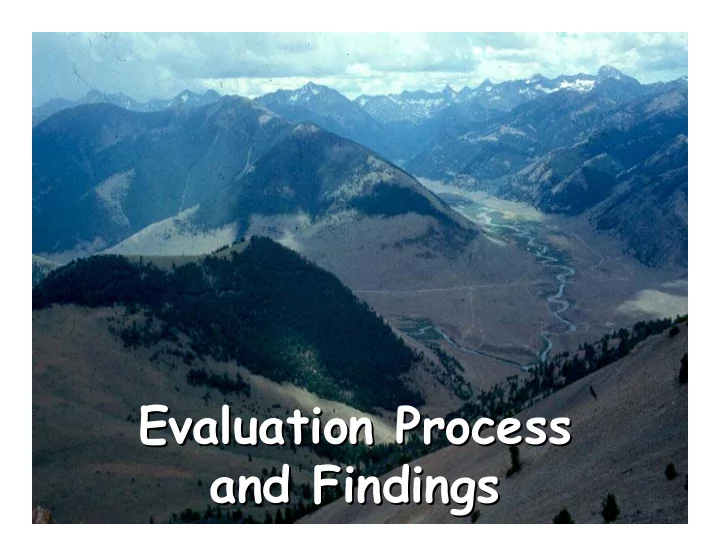

Evaluation Process Evaluation Process and Findings and Findings
Program Activities 300 briefings and presentations • 10,000 people 400 workshops • 12,000 people 175 service trips • 3,000 people
Program Evaluation 9 Evaluate effectiveness of original strategy 9 Indicate where program improvements could be made 9 Provide information about specific program activities and accomplishments
Program Evaluation Framework Program Evaluation Framework PARTICIPATORY RESEARCH Refine Program Description Design Evaluation Approach
Data Collection Surveys of PFC training session and service trip participants Demographic information Levels of satisfaction Barriers to success Indicators of short & long-term outcomes
Data Collection Interviews and focus groups with network members How does the initiative operate? What are its advantages and disadvantages? How are participants, including interviewees, affected? What are the on-the-ground outcomes? What are barriers to success?
Satisfaction ‘Extremely Satisfied’ • instructor attributes • products and services delivered Some Concern • availability and flexibility of NRST • effectiveness of outreach efforts
Did Particpant Knowledge Increase? no 100% yes 80% 60% 40% 20% 0% re lationship determining determine design importance of relationship between functionality minimum monitoring experienced between stream conditions strategies ID team function and attributes and relative to values processes stream potential and capability
PFC Training Sessions 9 Lack of diverse participation 9 Limited long-term improvement in cooperation
Extremely Serious Barriers to Cooperative Riparian-Restoration and Management 50% 40% 30% 20% 10% 0% s s s s t s d c s e t e e n e u i u v t c t r i i a i l n n s t t o / s n r c e e p t i e o s r s e l j n e a i b t f o r c a f o p i c c d i n e g i h n e l r n a u c c s i t r t e m n r u c e t e i m o l d f m s n l o o e o a c h r c d f e n o k u a k f t c s a l l l a t o n
Training sessions are important to building awareness and a shared understanding... ...the initiative’s mission cannot be fulfilled through training sessions alone .
PFC training sessions... “have been effective in getting the word out, building a common vocabulary and increasing awareness. But I don’t think it has led to as much tangible on- the-ground improvement as envisioned… The knowledge, appreciation, vocabulary and understanding is out there…But, in most cases, it has not been taken to that next level…”
On-The-Ground Improvements Associated with Service Trips 100% yes 80% no 60% 40% 20% 0% working cooperative improved riparian cooperatively management plans condition
Lower Rates of Success 9 Lack of up-front participation by all stakeholders. 9 Insufficient opportunities for dialogue and mutual learning. 9 Limited follow-up.
Recommendations Recommendations PFC training sessions... • Engage in deliberate and personal outreach • Combine training and place-based problem solving Service trips... • Use pre-work to encourage up-front participation • Facilitate opportunities for dialogue and mutual learning • Engage in follow-up activities Network... • Increase network ability to respond to a range of community needs
Creeks & Communities Develop a critical mass of people with shared understanding of riparian function and sustainability.
Addressing Addressing Institutional Barriers Institutional Barriers
Institutional barriers Institutionalization Process Agency Organizational Support Hierarchy Workforce Constraints
Agency Support • Differing levels of support from partnering agencies and individuals • Current organizational cultures do not create time and priority for the activities associated with this type of work • Bureaucracies are naturally resistant to risk taking, innovation and integration
Institutionalization Process • Few incentives for acting outside of traditional problem solving approaches • Few mechanisms for reporting benefits gained by employee participation in this initiative
We’re working to address this by: Developing mechanisms for evaluating and reporting accomplishments create operational structure continue evaluation and work to define appropriate performance measures
Agencies can help by: Identifying appropriate performance standards and developing indicators of short and long-term outcomes Endorsing on-going efforts - recognizing and rewarding success, while sharing experiences and drawing lessons from less successful efforts
Organizational Hierarchy Lack of clear and consistent message across all ‘appropriate lines of authority’ supporting innovative approaches to problem solving has been a barrier to agency support for this initiative
We’re working to address this by: Continuing to seek formal commitments of Washington Office support from partnering agencies Working to build line officer support through targeted briefings and training Pursuing on-going activities in the field
Agencies can help by: Providing a clear and consistent message supporting innovation and cooperation across all organizational levels Continuing to support innovative activities occurring within different levels Encouraging communication and coordination across all levels
Workforce Constraints Organizational downsizing + increasing responsibility = additional work !
Many agency employees trained in the bio- physical aspects of natural resource management... …some are disinterested or lack the skills to address the social dimensions of natural resource management.
There are not enough specialists available to participate in the type of interdisciplinary dialogue needed to properly assess specific riparian conditions... Vegetation Soil - Hydrology Landform
It is often difficult to share resources across disciplinary, programmatic and jurisdictional boundaries...
We’re working to address this by: Demonstrating how participation in this initiative helps employees meet other agency goals Expand Riparian Coordination Network through recruiting new members and diversifying training opportunities Work to partner with diverse organizations - increase flexibility, sharing of resources and our ability to work with private landowners.
Agencies can help by: Incorporating collaboration as part of job duties and performance packages Encouraging field-based training between more experienced and less experienced ID teams and specialists Enhancing flexibility for sharing resources across disciplines, programs and jurisdictional boundaries
Wrap up...
Recommend
More recommend